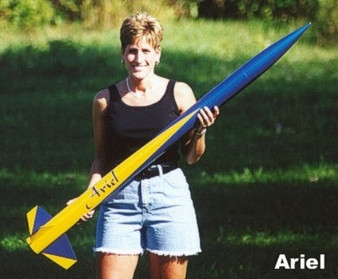Public Missiles PML Flying Model Rocket Kit 3.1" Spitfire PML 30385
Classic styling and superb stability make the Spitfire a great choice for beginners and seasoned flyers alike.
Spitfire stands over 50" tall with a diameter of 3.1". It is designed to fly on high impulse G motors for Pre-Cert flights and most H and I motors for Cert 1 flights. The Spitfire comes standard with a 38mm motor mount.
Height: 50.7"
38mm Motor Mount , Purchase an adapter to go down to 29mm Motors
Weight: 41oz
G10 Fin Thickness: 0.06"
Classification: Class 1, Level 1, Level 2
Motors: G thru J Motor Recommendations
3.1" Diameter Pre-slotted Quantum Tube Airframe
36" Nylon Parachute
Plastic Nose Cone
Rail Guides for 10/10 Rails
To use 29mm motors in a 38mm mount, purchase a motor adapter A2938
Recommended Motor Retainer Upgrade: RA38P
Skill Level Pro
Click here for the kit instructions
Click here to download RockSim v8/9 data for this rocket
Quantum Airframes:
The Quantum Tube (QT), is made from a special blended polymer that is extremely durable and easy to use. You will find this new material easy to work with and very forgiving. Most hobby type epoxies and paints will readily adhere to this material as well. The Quantum Tube can be squeezed, dropped, or even thrown and will not suffer any damage as can sometimes occur to cardboard or phenolic tube. The Quantum Tubes are molded in medium gray and have a glass smooth finish. The Quantum Tube does have one thing missing, the spiral groove! You will appreciate the fact that you no longer have to fill and sand the airframes to achieve the perfect finish. All PML rocket kits 2.1" dia. through 3.9" dia. come standard with Quantum Tube airframes.
Model Rocket Kits are rated by Skill Level
1 Beginner
2 Intermediate
3 Advanced
4 Expert
5 Master
Pro - High Power Rockets
If you are just starting in the hobby start at the beginner level and move up from there at your own pace.
What is needed to build and fly
All model rockets come in kit form that require assembly. The materials are primarily cardboard tubes, balsa or plastic fins and nose cone. Materials will vary by model and are typically specified in the description of each kit.
Additional supplies will be necessary to build and finish your model rocket kit and may include:
Scissors, Hobby Knife
Ruler
Wood Glue, Model Cement or CA(Super Glue)
Sandpaper
Masking Tape
Finishing Supplies like:
Wood Filler
Sealer/Primer
Paint
Launching Equipment and Supplies like:
Recovery wadding
Launch Pad
Launch Controller
Power supply
Model Rocket Motors and Igniters
A safe place to fly using guidelines from the National Association of Rocketry Safety Code that can be found at http://www.nar.org/NARmrsc.html
-
Public Missiles 3.1” Spitfire
Beautiful kit, arrived quickly and well packaged. Haven’t built it yet but looking forward to that and flying it. PML is a great line of kits.







